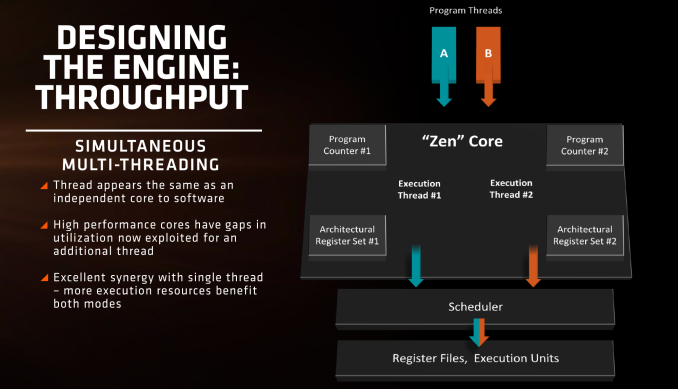AMD Zen Microarchitecture: Dual Schedulers, Micro-Op Cache and Memory Hierarchy Revealed
by Ian Cutress on August 18, 2016 9:00 AM ESTSimultaneous Multi-Threading
On Zen, each core will be able to support two threads in what is called ‘simulatenous multi-threading’. Intel has supported their version of SMT for a number of years, and other CPU manufacturers like IBM support up to 8 threads per core on their POWER8 platform designs. Building a core to be able to use multiple threads can be tough, as it requires a lot of resources to make sure that the threads do not block each other by consuming all the cache and buffers in play. But AMD will equip Zen with SMT which means we will see 8C/16T parts hitting the market.
Unlike Bulldozer, where having a shared FP unit between two threads was an issue for floating point performance, Zen’s design is more akin to Intel’s in that each thread will appear as an independent core and there is not that resource limitation that BD had. With sufficient resources, SMT will allow the core instructions per clock to improve, however it will be interesting to see what workloads will benefit and which ones will not.
Timeframe and Availability
At the presentation, it was given that Zen will be available in volume in 2017. As the AM4 platform will share a socket with Bristol Ridge, users are likely to see Bristol Ridge systems from AMD’s main OEM partners, like Dell and others, enter the market before separate Zen CPUs will hit the market for DIY builders. It’s a matter of principle that almost no consumer focused semiconductor company releases a product for the sale season, and Q1 features such events as CES, which gives a pretty clear indication of when we can expect to get our hands on one.
It’s worth noting that AMD said that as we get closer to launch, further details will come as well as deeper information about the design. It was also mentioned that the marketing strategy is also currently being determined, such that Zen may not actually be the retail product name for the line of processors (we already have Summit Ridge as the platform codename, but that could change for retail as well).
Wrap Up
AMD has gone much further into their core design than I expected this week. When we were told we had a briefing, and there were 200-odd press and analysts in the room, I was expecting to hear some high level puff about the brand and a reiteration of their commitment to the high end. To actually get some slides detailing parts of the microarchitecture, even at a basic cache level, was quite surprising and it somewhat means that AMD might have stolen the show with the news this week.
We’ve got another couple of pieces detailing some of the AMD internal/live benchmark numbers during the presentation, as well as the dual socket server platform, the 32-core Naples server CPU, and what we saw at the event in terms of motherboard design.











216 Comments
View All Comments
Jleppard - Thursday, August 18, 2016 - link
OR the first to 5 GHzKevin G - Saturday, August 20, 2016 - link
IBM hit 5 Ghz back in 2008 with the POWER6.JlHADJOE - Sunday, August 21, 2016 - link
Given how quickly they were able to implement x86_64, my bet is Intel already thought about extending x86 to 64bits, they just didn't want to do it because they were pushing Itanium hard at the time.But then AMD comes out with AMD64, and (rather predictably) the market loves it, which puts a real damper on Intel's Itanium push and eventually they are forced to capitulate and follow suit.
hansmuff - Thursday, August 18, 2016 - link
Everyone copies success, what's new?bill.rookard - Thursday, August 18, 2016 - link
Well, it's not a complete copy. There are some difference which should make it interesting to see how the chips line up against each other. x2 L2 cache on Zen vs x2 L3 cache on Intel, the larger core/thread counts (let's hope they offer the 8c/16t to consumers), and of course, the big one being how this all affects the integrated graphics in APU form.Will the change to 16nm FinFET allow them to put in more GPU? What kind of clocks and/or power envelope will this run at? A lot of this makes a huge difference in the types of systems which can be made - a powerful hex-core CPU with a beefier IGP in a 60-80w TDP would be nice to see.
smilingcrow - Thursday, August 18, 2016 - link
There is definitely gong to be a consumer 8c/16t chip.Ian Cutress - Thursday, August 18, 2016 - link
The 8c will be coming to consumers in the AM4 chipset in Q1. :)Flunk - Thursday, August 18, 2016 - link
I wonder what the resale value of my 6700K and Z170 board will be in Q1 ;).Morawka - Thursday, August 18, 2016 - link
you'll get more cores but not more IPC. all signs point to skylake being at least 2 years ahead of zen, although since intel has barely increased performance in 2 years, it shouldnt make to big of a difference, in gaming at least.tamalero - Friday, August 19, 2016 - link
Disagree, the performance boost of each generation is always less than 5% in the last designs by intel.Only a few tests show really higher performance per clock.